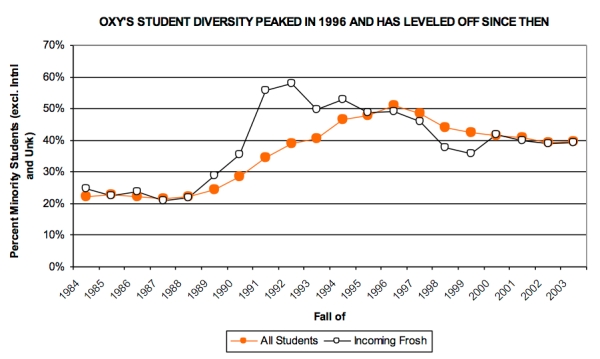The mission of Occidental College is to provide a gifted and diverse group of students with a total educational experience of the highest quality — one that prepares them for leadership in an increasingly complex, interdependent and pluralistic world. (Oxy website)
“We have to be truthful, on some level, about our commitment to diversity, and we are very diverse … If you’re looking for schools like Occidental, you won’t find more than two schools with more diversity than us. People would die to have the diversity that we have in place.” –Jorge Gonzalez (bold added, accessed Aug. 9, 2013)
• • • • •
Diversity was the only criteria for which Occidental College reached a position in the top ten lists of US News and World Report; this was in 1998 when it ranked number one. Now in 2013, Occidental College, in the same category, has declined and is tied for the number 12 spot.
The Faculty
Integral to the mission of equity and diversity is faculty composition. Currently in 2013, 71% of the faculty remains Caucasian; 12% Asian; 10% Latino/a; 7% African-American. Is this the diversity people would die for?
In 1979, there was a lone African-American woman; in the fall of 2013, there are three. Is this progress?
 * *Sources: Beams Team Summer Academy Findings: Recommendations for Latino/a Retention, Sept. 2004; Occidental College, 2013.
* *Sources: Beams Team Summer Academy Findings: Recommendations for Latino/a Retention, Sept. 2004; Occidental College, 2013.
The Students
At the height of equity in the mid- to late 1990s, incoming classes were over 50% students of color. Currently, it has dropped to approximately 37%. Is this progress? Is this the diversity people would die for?
* Source: 2005 Diversity Scorecard Report to Pres. Ted Mitchell.


Good start in focusing on diversity issues at Oxy. I don’t think focusing on percentages — such as Oxy vs NELA, for instance — is as important as defining concrete actions that the school should be taking. Given that Oxy is an LA college, of course, it should definitely be high in the diversity top 10, rather than 13 as it is today. Students, faculty and alumni should get together to define world-class programs that will make more minority students choose Oxy and then give them the financial and social support they need to succeed. The new Latino studies program seems to be a good example (is it?). But there must be an African-American studies major and stronger Asian programs as well. The administration has consciously pulled back its support for East Asian history, for example, whereas Oxy should have the best Chinese, Japanese and Korean programs of any liberal arts college in the country.
The student numbers do show us the biggest problem at Oxy today, not nearly enough African-Americans, particularly males. There is a higher percentage of white students at Howard University today than black students at Oxy. The deficiency is, I suppose, a combination of lack of will, economics, and lack of programs that will make more black students choose Oxy. Whatever’s happening, it needs to be changed.
Latino enrollment is not as bad, but still needs to be higher. I don’t think Oxy’s Latino enrollment has to be 80% to match Highland Park, but it should be higher than the national average.
Asian-American enrollment is higher than the national average but makes sense given Oxy’s California location.
Generally, I suppose Oxy should aim for at least 50% minority students, if not slightly more.
Also, someone needs to do a class analysis of Oxy students rather than just an ethnic breakdown. If Oxy is to make a true commitment to equity, then more students from poor and working class backgrounds need to be brought in and supported.
At the scholarship level, more scholarships need to be set up for African-American and Latino students in order to get the diversity the college needs.
I think faculty diversity may be a bit harder to come by. I don’t know the ethnic breakdown of college faculty nationwide, but I’ll bet it’s worse than the population averages or student percentages. Diversity is probably more important in departments like history, diplomacy, social sciences and literature than it is in the hard sciences, where I suspect it’s hard to come by.
I hope that we can get interested alumni to get together with students and faculty to see what kinds of specific programs should be proposed and then funded.
Good luck to everyone in C.O.D.E!
Thanks for the thoughtful and supportive comment. This will be posted to codeoxy.tumblr.com.
Diversity in the natural sciences is very much needed. A more heterogenous population, bringing in different vantage points, enables scientists to overcome biases. The process of science is all about leveraging different pairs of eyes on experiments to better understand how the universe works instead of dwelling on how we wish/want it to work.
Of those earning PhDs in the natural sciences, Hispanics and African Americans are underrepresented. However, those that do pursue a PhD in the natural sciences are very talented. A well designed search, especially given Occidental’s location, should attract a diverse and strong pool to choose a great faculty member from.
When it comes to PhDs, a disproportionate number of them went to small liberal arts colleges. If as a society we want to increase the percentage of Hispanics and African Americans in the natural sciences, places like Occidental must be leaders.
Thank you for your thoughts. Your comment has been cross-posted to codeoxy.tumblr.com, which has a bigger readership. We have attributed it to “Dr. KstRNA”.